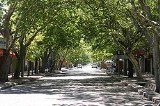
San Rafael, Mendoza
Encyclopedia
San Rafael is a city in the southern region of the Mendoza Province
, Argentina
. With more than 170,000 inhabitants , it is the largest city and the seat of San Rafael Department
.
The city is located 240 km from the provincial capital
and 990 km from the federal capital
. Natural attractions in the area include the Diamante River, which flows through the city, the rapids-strewn Atuel River
just south and Lake Los Reyunos, 20 km (12 mi) west of San Rafael.
from what today is Chile
first surveyed the area in 1551 and, finding a well-established agricultural Coquimbo
and Diaguita
cultures, they rapidly subdued the existing peoples and expropriated the land. Displaced Pehuenche
s revolted, however, and repeated attacks led to an 1804 treaty signed by Viceroy Rafael de Sobremonte
whereby the Pehuenches ceded land to colonial authorities. The construction of Fort San Rafael del Diamante and its 2 April 1805 completion marked the formal establishment of San Rafael.
San Rafael remained relatively isolated from the rest of the country, long after independence in 1816. The area's agricultural potential and strategic location were eventually brought to the federal government's attention. In 1871, civil engineer Julio Balloffet was commissioned to oversee the development of San Rafael. His efforts were centered around needed public works, among which were civic buildings, schools, plazas, a hospital, cathedral and irrigation works. The irrigation canals were accompanied by an agricultural laboratory and a panel of agronomists and, by 1900, the San Rafael area fruit orchards had attracted a sizable contingent of Italian and French immigrants.
This sudden prosperity led to San Rafael's formal designation as department seat in 1903 and, that November, the expanding railways
reach the city. The railways led to the local development of food processing
industries, as well as to the town's designation as a "city" in 1922. The torrential Atuel
and Diamante River
s facilitated the construction of a number of important hydroelectric dams in the area, bringing further prominence to San Rafael as an economic and tourist hub within southern Mendoza Province. The first, the Nihuiles Hydroelectric Dam, was inaugurated in 1953 on the Atuel River. The facility, which generates around 1000 MWh annually (today nearly 1% of the entire nation's), also resulted in the creation of a 9000 hectare (35 mi2) reservoir, bringing with it growing recreational tourism into the area. A similarly important work, Los Reyunos Dam
, was built on the Diamante River, south of San Rafael. Inaugurated in 1984, the reservoir has also proven popular among weekend getaway vacationers and retirees. The city, since 1968, has also hosted auto racing competitions at its La Paredes Autodrome, including numerous ones for Argentina's prestigious TC 2000
touring car racing
competitions.
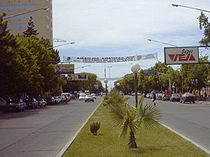

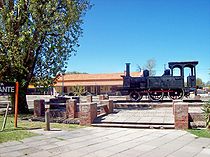

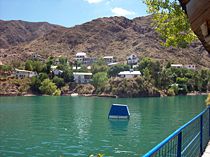
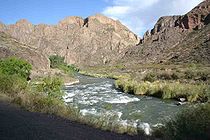
Mendoza Province
The Province of Mendoza is a province of Argentina, located in the western central part of the country in the Cuyo region. It borders to the north with San Juan, the south with La Pampa and Neuquén, the east with San Luis, and to the west with the republic of Chile; the international limit is...
, Argentina
Argentina
Argentina , officially the Argentine Republic , is the second largest country in South America by land area, after Brazil. It is constituted as a federation of 23 provinces and an autonomous city, Buenos Aires...
. With more than 170,000 inhabitants , it is the largest city and the seat of San Rafael Department
San Rafael Department
San Rafael is one of the departments of Mendoza Province, Argentina. The seat of the department is in the city of San Rafael.-Statistics:*Geographical location: 34º 15´ to 36º southern latitude and 70º 10´ to 66º 55´ eastern longitude....
.
The city is located 240 km from the provincial capital
Mendoza, Argentina
Mendoza is the capital city of Mendoza Province, in Argentina. It is located in the northern-central part of the province, in a region of foothills and high plains, on the eastern side of the Andes. As of the , Mendoza's population was 110,993...
and 990 km from the federal capital
Buenos Aires
Buenos Aires is the capital and largest city of Argentina, and the second-largest metropolitan area in South America, after São Paulo. It is located on the western shore of the estuary of the Río de la Plata, on the southeastern coast of the South American continent...
. Natural attractions in the area include the Diamante River, which flows through the city, the rapids-strewn Atuel River
Atuel River
The Atuel River is a river located mainly in the south of the Argentine province of Mendoza, with its last part in La Pampa. It is a tributary of the Desaguadero River....
just south and Lake Los Reyunos, 20 km (12 mi) west of San Rafael.
History
Spanish expeditions led by Francisco de VillagraFrancisco de Villagra
Francisco de Villagra Velázquez was a Spanish conquistador, and three times governor of Chile.-Early life:Born at [Santervás de Campos], he was the son of Alvaro de Sarría and Ana Velázquez de Villagra, who were not married. For this reason he took the name of his mother...
from what today is Chile
Chile
Chile ,officially the Republic of Chile , is a country in South America occupying a long, narrow coastal strip between the Andes mountains to the east and the Pacific Ocean to the west. It borders Peru to the north, Bolivia to the northeast, Argentina to the east, and the Drake Passage in the far...
first surveyed the area in 1551 and, finding a well-established agricultural Coquimbo
Coquimbo
Coquimbo is a port city, commune and capital of the Elqui Province, located on the Pan-American Highway, in the Coquimbo Region of Chile. Coquimbo lies in a valley south of La Serena, with which it forms Greater La Serena with more than 400,000 inhabitants. The commune spans an area around the...
and Diaguita
Diaguita
The Diaguita, also called Diaguita-Calchaquí, are a group of South American indigenous peoples. The Diaguita culture developed between the 8th and 16th centuries in what are now the provinces of Salta, Catamarca, La Rioja and Tucumán in northwestern Argentina, and in the Atacama and Coquimbo...
cultures, they rapidly subdued the existing peoples and expropriated the land. Displaced Pehuenche
Pehuenche
Pehuenches are an indigenous people that are part of the Mapuche peoples and live in the Andes in south central Chile and Argentina. Their name derives from their habit of harvesting of piñones, the seeds of the Araucaria araucana or pehuén...
s revolted, however, and repeated attacks led to an 1804 treaty signed by Viceroy Rafael de Sobremonte
Rafael de Sobremonte
Don Rafael de Sobremonte y Núñez del Castillo, 3rd Marquis of Sobremonte , third Marquis of Sobremonte, was an aristocrat, military man and Spanish colonial administrator, and Viceroy of the Río de la Plata...
whereby the Pehuenches ceded land to colonial authorities. The construction of Fort San Rafael del Diamante and its 2 April 1805 completion marked the formal establishment of San Rafael.
San Rafael remained relatively isolated from the rest of the country, long after independence in 1816. The area's agricultural potential and strategic location were eventually brought to the federal government's attention. In 1871, civil engineer Julio Balloffet was commissioned to oversee the development of San Rafael. His efforts were centered around needed public works, among which were civic buildings, schools, plazas, a hospital, cathedral and irrigation works. The irrigation canals were accompanied by an agricultural laboratory and a panel of agronomists and, by 1900, the San Rafael area fruit orchards had attracted a sizable contingent of Italian and French immigrants.
This sudden prosperity led to San Rafael's formal designation as department seat in 1903 and, that November, the expanding railways
Rail transport in Argentina
The Argentine railway network comprised of track at the end of the Second World War and was, in its time, one of the most extensive and prosperous in South America. However, with the increase in highway construction, there followed a sharp decline in railway profitability, leading to the break-up...
reach the city. The railways led to the local development of food processing
Food processing
Food processing is the set of methods and techniques used to transform raw ingredients into food or to transform food into other forms for consumption by humans or animals either in the home or by the food processing industry...
industries, as well as to the town's designation as a "city" in 1922. The torrential Atuel
Atuel River
The Atuel River is a river located mainly in the south of the Argentine province of Mendoza, with its last part in La Pampa. It is a tributary of the Desaguadero River....
and Diamante River
Diamante River
The Diamante River is a river in the Argentine province of Mendoza. It is born from glaciers on the Maipo, a volcano in the Andes range in the Argentine–Chilean border, and flows east until emptying in the Desaguadero River...
s facilitated the construction of a number of important hydroelectric dams in the area, bringing further prominence to San Rafael as an economic and tourist hub within southern Mendoza Province. The first, the Nihuiles Hydroelectric Dam, was inaugurated in 1953 on the Atuel River. The facility, which generates around 1000 MWh annually (today nearly 1% of the entire nation's), also resulted in the creation of a 9000 hectare (35 mi2) reservoir, bringing with it growing recreational tourism into the area. A similarly important work, Los Reyunos Dam
Los Reyunos Dam
The Los Reyunos Dam is a dam on the Diamante River, in central Mendoza Province, Argentina, some twenty-two miles from the city of San Rafael. The dam, built of stone and compacted clay to minimize execution and cost, is 440 feet high and contains a reservoir covering an area of 1,828 acres .The...
, was built on the Diamante River, south of San Rafael. Inaugurated in 1984, the reservoir has also proven popular among weekend getaway vacationers and retirees. The city, since 1968, has also hosted auto racing competitions at its La Paredes Autodrome, including numerous ones for Argentina's prestigious TC 2000
TC 2000
The TC 2000 Championship is a touring car racing series held in Argentina since 1979. It's considered the most advanced racing car series in South America and one of the top 10 touring car series in the world.-Rules:...
touring car racing
Touring car racing
Touring car racing is a general term for a number of distinct auto racing competitions in heavily-modified street cars. It is notably popular in Argentina, Australia, Brazil, Germany, Japan, Scandinavia and Britain.-Characteristics of a touring car:...
competitions.






External links
- Municipality of San Rafael — Official website.
- Diario San Rafael

